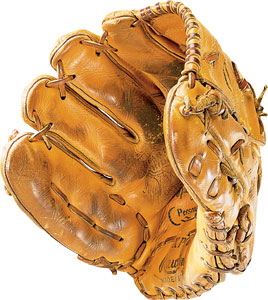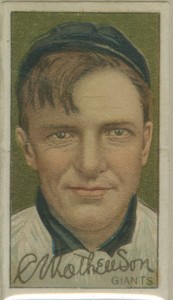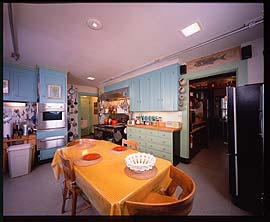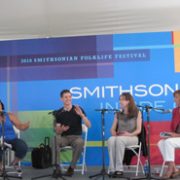We invited our recent Smithsonian Affiliate interns and visiting professionals to blog about their experiences in our “Summer at the Smithsonian” series. Below, Lisa Falk, Director of Education at Arizona State Museum (Tucson), describes her residency at the Smithsonian. Special thanks to Lisa for this post!
 As I crisscrossed the Mall and marched to Smithsonian sites beyond, I clutched my cell phone and lugged my laptop, always mobile and ready for my daily Smithsonian adventure. The Smithsonian is embracing mobile technologies as it strives to serve visitors in their museums and in cyberspace. My Visiting Professional residency provided me the contacts and time to learn about the ways the Smithsonian is engaging visitors through digital means as well as some more low-tech “human” engagements in their halls.
As I crisscrossed the Mall and marched to Smithsonian sites beyond, I clutched my cell phone and lugged my laptop, always mobile and ready for my daily Smithsonian adventure. The Smithsonian is embracing mobile technologies as it strives to serve visitors in their museums and in cyberspace. My Visiting Professional residency provided me the contacts and time to learn about the ways the Smithsonian is engaging visitors through digital means as well as some more low-tech “human” engagements in their halls.
Each week I visited different museums and spoke with my colleagues about their work. Days were filled with talking, observing, and playing. As I texted my way through museum exhibits, playing several digital games and even creating some, I realized that cell phones are more than devices for making calls on; at the Smithsonian they became guides for discovery. With so many excited educators working with content managers and web and mobile developers, many new ways to experience the resources of the museums are being developed and tested. It was exciting to be around so much spark!
Week One: National Museum of the American Indian, D.C. and NYC.
In D.C. I learned about their Cultural Interpreter program that has Native educators work with visitors on the floor giving tours, demonstrations, and instruction for hands-on crafts projects (I learned to weave a basket!) among many other exciting initiatives.
At NMAI in NYC I visited exhibits and spoke with staff about film programming. Arizona State Museum already collaborates on our Native Eyes Film Showcase with NMAI and this gave me the opportunity to learn a bit more about what they do and plan for our next festival. I tested a new text messaging quiz initiative their visitor services manager is offering to attract more Latino visitors to NMAI’s galleries. It has spurred an idea for a text messaging quiz I want to develop in conjunction with a new exhibit opening at ASM this fall.
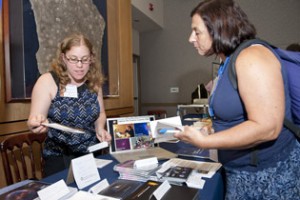 Week two: Smithsonian Affiliates Conference and Mobile Media Learning workshops
Week two: Smithsonian Affiliates Conference and Mobile Media Learning workshops
During the Affiliations National Conference, I heard and saw a lot! As my focus is digital, the high point for me was playing the Ghosts of a Chance game with my peers. We interacted together in the galleries at the Smithsonian American Art Museum and talked with a developer about how the game was created. We dashed through the halls discovering clues from art works, computer collection information, and even made tin foil sculptures. I think I saw more of the museum in one visit than I ever have before!
At the Mobile Media workshops, we used Nokia phones to photograph objects and add augmented reality information to them, i.e.: we created short video that added meaning to the objects. It was good to have hands-on time actually trying to create using cell phone technology and to work with other peers as we questioned not only how the technology worked, but how we could use it, and how youth might interact with it.
Week Three: National Museum of American History
 The high point was talking with Xavier Carnegie, Actor and Trainer for museum theater programs. He spoke about the power of theater to emotionally involve visitors with the history and ideas behind museum objects. Observing him in two different on-floor drama presentations was powerful.
The high point was talking with Xavier Carnegie, Actor and Trainer for museum theater programs. He spoke about the power of theater to emotionally involve visitors with the history and ideas behind museum objects. Observing him in two different on-floor drama presentations was powerful.
Week Four: Meetings with digital media strategists and the Smithsonian Folklife Festival
I hopped around this week, gleaning knowledge from different sources. At the American Art Museum I further explored the digital media text messaging scavenger hunts in the Luce gallery as well as cell phone audio tours, and old-fashioned paper-based treasure hunts.
At National Museum of Natural History I enjoyed talking with staff about how they approach the use of digital media, particularly with their Facebook page. They see the Facebook page as a very interactive program where they disseminate information, questions, and encourage comments and questions.
The highlight at NMNH was my meeting with Robert Costello who developed a web comic to go with the Written in Bone exhibit. I’m also trying to develop a web comic so it was great to talk with a colleague who had already done the research on youth use of such a tool and had evaluation notes showing how people were using it (more adults then youth seem to use it!).
 On my last day, in honor of my explorations, I was invited to moderate a panel about digital media at the Smithsonian on one of the stages at the Folklife Festival. Smithsonian staff spoke about how their jobs had changed over time and how they were approaching making their resources available using digital media. The audience expressed interest in access to content and images and applauded their efforts.
On my last day, in honor of my explorations, I was invited to moderate a panel about digital media at the Smithsonian on one of the stages at the Folklife Festival. Smithsonian staff spoke about how their jobs had changed over time and how they were approaching making their resources available using digital media. The audience expressed interest in access to content and images and applauded their efforts.
During my residency I was all over the place, but it was a great! The connecting strand was audience involvement with Smithsonian resources and using digital media to engage and reach out. My SI colleagues were inviting, open, and encouraging. Their work is inspiring and has given me many ideas and broadened my understanding of the possibilities and some of the difficulties in creating digital and face-to-face museum interactions! I look forward to sharing what I learned with my ASM colleagues and trying out some of the Smithsonian approaches.







